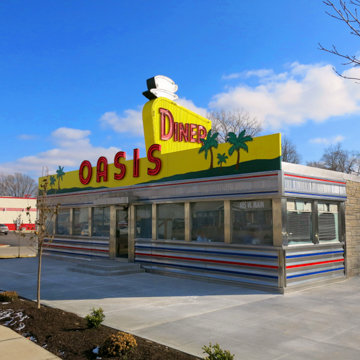You are here
Oasis Diner
The Oasis Diner is a historic prefabricated diner, manufactured by Mountain View Diners in Singac, New Jersey. The diner was delivered by train and opened in 1954 between Plainfield and Indianapolis along U.S. Route 40, an important transcontinental highway. It has stood as a regional landmark for generations.
The building displays several elements typical of the Streamlined Moderne style, with its horizontal emphasis, large expanses of glass, stainless steel and chrome hardware, and brightly colored horizontal grooves along the exterior facade. The interior is dominated by a central service counter, with a preparation area and kitchen against the back wall, and floor-mounted stools and booths situated throughout the front. The neon sign, which displays the diner’s name alongside palm trees, creates a vertical contrast to the diner’s flat roof.
The Oasis Diner was developed along with the adjacent “40” Motel, a typical combination of post–World War II roadside architecture. Both the motel and the site-built wing of the diner (adjacent to the rear) featured random ashlar Bedford limestone veneer, a popular material in Indiana during the 1950s. The original owners of the Oasis Diner were James Canavan and Frank Thurber. Canavan operated the diner until he sold it to George and Mona Thompson in 1973. The Thompsons ran the diner until 1982, when it was purchased by Walter and Evelyn Dininger, who then sold it to Raymond Piercy in 1987. Piercy owned and operated the diner until 2008. By that time, a new four-lane highway was built 400 feet west of the property. The new infrastructure and increased traffic added pressure for the addition of suburban strip development around the site, raising property values and making the operation of the diner cost-prohibitive to its owner.
After closing in 2008, the diner sat vacant and endangered by encroaching suburban sprawl. In 2010, Indiana Landmarks listed it on its 10 Most Endangered Buildings list, which prompted the Town of Plainfield to hire RATIO Architects to prepare a feasibility study for the relocation and rehabilitation of the historic diner. The Town of Plainfield, Indiana Landmarks, and the Indiana National Road Association worked with the diner’s longtime owners to arrange for the donation of the diner to the town on the condition that it be preserved and moved to a new site. Relocated four miles west of the diner’s original location, adjacent to a new pedestrian bridge at the western gateway to the town center, the new site has high visibility for all motorists traveling east along U.S. 40, retaining the diner’s historic relationship to the highway.
Throughout its history, the Oasis Diner has undergone several alterations, including the removal of its original neon sign, which was later recreated from historic photos and reinstalled in its original position. The diner rests atop a new foundation and most of the structure and materials have been retained and refurbished. A new rear addition, based on the design of the original and clad in the original Bedford limestone veneer, was built to the rear to provide modern kitchen and bathroom facilities to meet present building codes. The diner retains its original interior, with pink and gray Formica plastic laminate with stainless steel trim, as well as its original tables and seating.
The Oasis Diner reopened in its current location in November 2014 and now serves as a key landmark at a gateway to Plainfield’s downtown. The Oasis Diner is the last historic diner remaining along the National Road in Indiana and one of only two surviving diners in the Indianapolis area.
References
“2014 Year in Review.” Indiana Landmarks. Accessed June 8, 2016. http://www.indianalandmarks.org/.
Nicodemus, Theresa. “The Oasis Diner: Flashback to the fabulous fifties.” Senior Life Newspapers, February 16, 2015.
“Oasis Diner History.” Oasis Diner. Accessed June 8, 2016. http://www.oasisdiner.com/.
Ross, Benjamin L. “Plainfield, Indiana: Revitalization along the National Road.” Preserving the Historic Road, Eighth Biennial Conference on Historic Roads, Indianapolis, Indiana, 2012.
Writing Credits
If SAH Archipedia has been useful to you, please consider supporting it.
SAH Archipedia tells the story of the United States through its buildings, landscapes, and cities. This freely available resource empowers the public with authoritative knowledge that deepens their understanding and appreciation of the built environment. But the Society of Architectural Historians, which created SAH Archipedia with University of Virginia Press, needs your support to maintain the high-caliber research, writing, photography, cartography, editing, design, and programming that make SAH Archipedia a trusted online resource available to all who value the history of place, heritage tourism, and learning.

